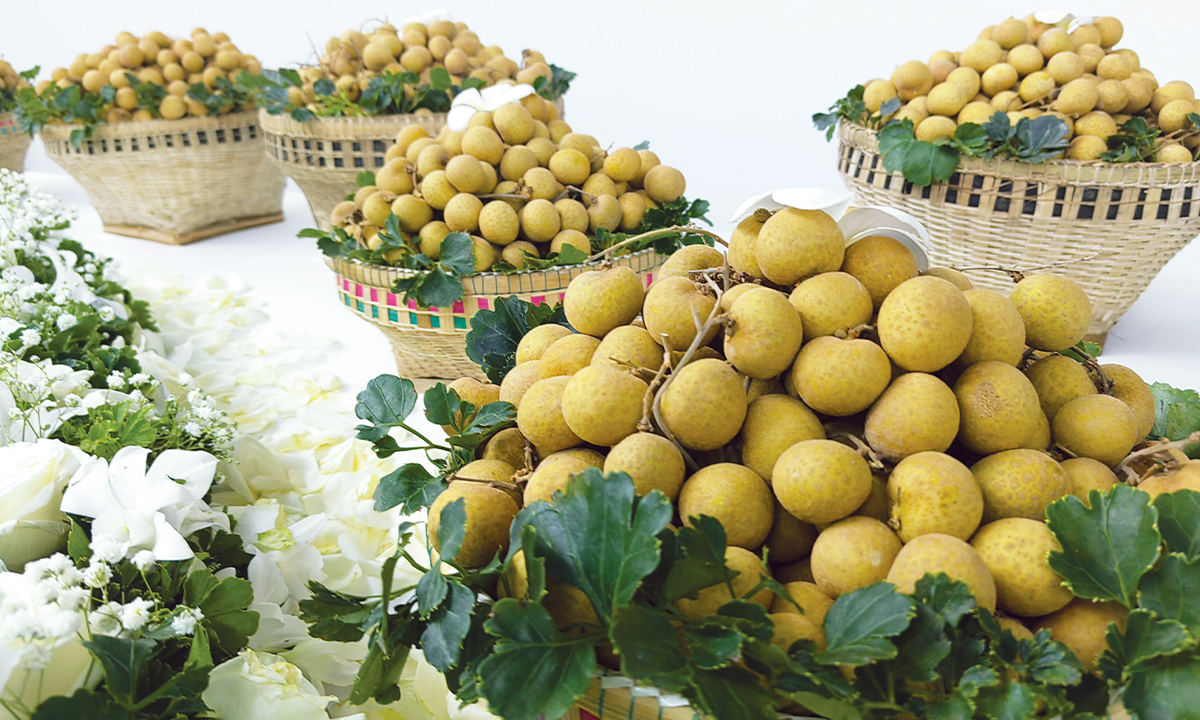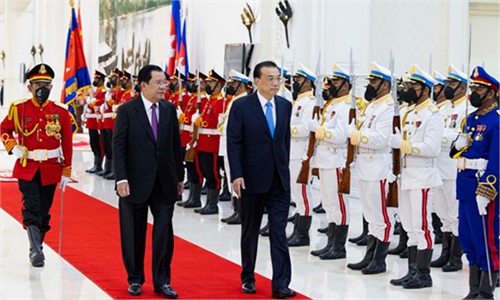China-Cambodia time-honored friendship bears fruits in agricultural cooperation and beyond
Longan export debuts, a microcosm of how the BRI helps regional agricultural trade for strong boost

Longans are displayed at the launch ceremony of longan exports to China held in Phnom Penh, Cambodia on October 27, 2022. Photo: VCG
Editor's Note:
China-Cambodia relations have continued to improve, becoming a model of regional cooperation at a time when the world is full of challenges and opportunities. China is the first country to sign a bilateral free trade agreement with Cambodia, which took effect on January 1, the same day as the Regional Comprehensive Economic Partnership Agreement came into effect - both have produced a knock-on effect on the Cambodian economy. With the entry into force of the agreements, the bilateral trade volume exceeded the $10 billion mark two years ahead of schedule. Cambodian agricultural products including bananas, mangoes, rice and longan were placed on the table of the Chinese people. While Chinese Premier Li Keqiang's visit to Cambodia highlighted two good neighbors and friendly cooperation, the two countries under the Belt and Road Initiative (BRI) are ushering in the new era of the community of a shared future.
At Pailin province in western Cambodia, local farmers have come to their busiest time of the year as the harvest time of longan has just begun in October and can last until May next year. Different from any other time, Pailin, the country's major production base for longan, has secured big orders against the backdrop of a new deal inked between China and Cambodia on October 27, marking the official debut of Cambodian longan export to China, its largest market for agricultural products, after banana and mango.
Cambodian longan came across export difficulties during the harvest season last year, and some longans did not make it to market. In order to help solve the practical problems affecting the livelihood of Cambodian fruit farmers, China's General Administration of Customs innovated its working methods to accelerate the process of exporting Cambodian longan to China, while efficiently completed the phytosanitary risk assessment of Cambodian longan exporting to China through remote video, Chen Qisheng, general manager of China Certification and Inspection Group Cambodia Co, told China News Agency.
Through Sihanoukville port, these longans are expected to arrive at Beibu Gulf Port in South China's Guangxi Zhuang Autonomous Region within just a week.
Chen Yanhua, executive chairman of the Cambodia Chinese Chamber of Commerce told the Global Times that longan is Cambodia's third agricultural product approved for export to China after pangasius and corn earlier this year, and the third fruit product approved for export to China, representing a new substantive achievement for China-Cambodia agricultural cooperation despite the epidemic, while bringing tangible benefits to the two peoples.
"It is expected that 100,000 tons of Cambodian longan will be exported to China this year," Chen said, indicating an up to 70 percent of the country's total production.
While Cambodian longan was successfully exported to China, the standardization and processing level of local longan cultivation has also been enhanced.
With the participation of local Chinese companies, the standardization of agricultural production in the region is improving, whether it is the processing of dried longan or the grading and packaging of fresh fruit, industry insiders said.
Meanwhile, the exports of other Cambodian agricultural goods such as pepper, wild aquatic products, edible bird's nests, and coconuts to China are being accelerated, according to Chen.
All-round cooperation
Longan exports are just a tip of an iceberg for the China-Cambodia ties. China is not only the most potential market for Cambodian fruits but the participation of Chinese companies with advanced infrastructure and management capabilities has created a complete mass production line and distribution channel for local farming and export, exemplified by the construction of Hunty Cambodia National Agricultural Industrial Park, one of the key agricultural development projects in Cambodia.
Sun Tonghe, general manager of the Cambodia branch under China Civil Engineering Construction Corporation, told the Global Times on Thursday that construction at the first phase of Hunty Agricultural Industrial Park has been completed, and the project is at the final stage of completion settlement.
Located at Preah Sihanouk province, the Hunty Agricultural Industrial Park is the first standard modernized agricultural industrial park in Cambodia, with an area of 88 hectares. Once completed, it will be able to provide a one-stop convenient service for the fresh exports of Cambodia's high-quality agricultural good exports, and could significantly drive local employment and industrialization of the local agricultural industry.
"The main agricultural production base in Cambodia is located surrounding the Tonle Sap Lake. The area is rich in green agricultural resources but undeveloped in inland water transportation, which makes the cost of shipping agricultural products quite high," Sun said, adding that in the future, Chinese companies could invest in opening more inland water routes and make such way of transportation one of the most cost-effective means in Cambodia.
Sun also suggested Chinese state-owned companies should participate and expand investment in the construction of railway and highway connecting the capital of Phnom Penh with Vietnam, Laos and Thailand, so as to "further bring down the logistic cost of bilateral trade."
"We could also help to improve the local storage and cold-chain transportation capacity, which will raise the delivery efficiency and economic benefits. We expect to see more cooperation between Cambodian firms and Chinese large-scale logistic and warehouse companies," Sun noted.
Fruitful outcomes
The BRI and the China-Cambodia Free Trade Agreement have brought positive changes and benefits to Cambodian agriculture and beyond.
Speaking as a direct witness of how China proposed BRI and the bilateral free-trade agreement have brought about changes to the local economy and trade, Chen said that the Cambodian economy depends on agricultural development, especially the production of crops, but the relatively low level of agricultural technology development in the region limits its agricultural production capacity and export competitiveness.
Through bilateral cooperation with China, Cambodia has promoted the upgrading of agricultural production technology, infrastructure construction and financial resources, Chen said.
Since the beginning of this year, Cambodian agricultural product exports have grown rapidly, with China's market position and role becoming increasingly prominent to the country.
From 2019 to the end of June 2022, Cambodia exported 2.4 million tons of agricultural products to China equal to a total value of $1.942 billion, including fresh bananas, rice, dried tapioca chips, tapioca flour, according to the Cambodia Chinese Chamber of Commerce.
"The BRI has helped Cambodia to plant rice, cassava, tropical fruits, natural rubber and other products. Through the establishment of agricultural product processing parks, the added value of agricultural products has been enhanced," Chen.
"Further in-depth cooperation should be carried out in the aspects of agricultural product processing and food hygiene and agricultural mechanization and industrialization...in this way, Cambodia will unleash a new opportunity for the development of agriculture," the chairman said.
The noteworthy achievements in the construction of a community of shared future between the two countries have brought tangible benefits to the two peoples, exemplified by the constant progress in the bilateral cooperation in multiple areas ranging from agriculture to infrastructure and manufacturing.
The Sihanoukville Special Economic Zone (SSEZ), the signature project under the BRI, attracted 170 companies from around the world to settle in, creating nearly 30,000 jobs.
The BRI has put Cambodia's SSEZ on the fast track that evolved the port from an obscure small fishing village into a modern city that has attracted worldwide attention, integrating diversified business industries ranging from finance and tourism to free trade, Chen said.
Due to the influx of foreign capital and people into Sihanoukville, numerous entrepreneurial platforms and employment opportunities have now been created for Cambodians in Sihanoukville and surrounding areas.
Infrastructure project such as the Siem Reap International Airport is nearly halfway completed. The Chinese-invested expressway the Phnom Penh-Sihanoukville (PPSHV) Expressway, connecting the Cambodian capital of Phnom Penh to the international deep-sea port province of Preah Sihanouk, the first of its kind in the country, is completed, injecting strong momentum of growth for country's economy.
Cambodia is a small country in the Association of Southeast Asian Nations but it is the one that has the closest partnership with China, with no political issues unsolved in between, not to mention that on many regional and international issues, China and Cambodia support each other and have a high degree of consensus, Zhao Gancheng, a research fellow at the Shanghai Institute for International Studies, told the Global Times.
Given all circumstances, cooperation between China and Cambodia should be a model of cooperation between a big country and a small country, with greater potential to explore as a community with a shared future, Zhao said.


